![]()
![]()
![]()
Use LEFT and RIGHT arrow keys to navigate between flashcards;
Use UP and DOWN arrow keys to flip the card;
H to show hint;
A reads text to speech;
13 Cards in this Set
- Front
- Back
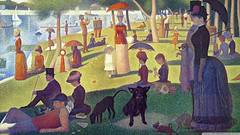
|
Artist: George Seurat Title: A Sunday on La Grande Jatte Date: 1884-86 Period: Post Impression Medium: Oil on canvas The Art Institute of Chicago Seurat worked for over a year on this painting, preparing it with 27 preliminary drawings and 30 color sketches. Seurat avoided lines to to define contours and depended instead on shading to achieve soft, penumbral effects. In the prep work, ranging from studies to of individual figures to oils that laid in most of the final composition, Seurat analyzed, in meticulous detail, every color relationship and every aspect of pictorial space. Seurat's unique color system was based on the Impressionist's realization that all nature was color, not neutral tone. But they made no scientific, organized effort to achieve their remarkable optical effects. Seurat constructed his canvases with an overall pattern of small, dotlike brushstrokes of generally complementary colors with white. Neo-Impressionism/Pointillism |
|
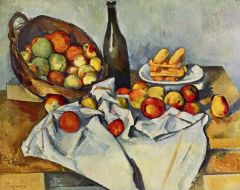
|
Artist: Paul Cezanne Title: Still Life with Basket of Apples Date: 1893 Period: Post Impressionism Medium: Oil on canvas The Art Institute of Chicago Cezanne struggled throughout his life to express in paint his ideas about nature of art, ideas that were among the most revolutionary in the history of art. Cezanne's unusual combination of logic and emotion represented the synthesis that he sought in his paintings. In the 1870s the Impressionists largely abandoned traditional drawing in an effort to communicate a key visual phenomenon--that objects in nature are not seen as separated from one another by defined contours. Cezannes's conviction that Impressionism ignored qualities of Western painting important since the Renaissance prompted his oft-quoted (and frequently misunderstood) remark that he wanted to "make of Impressionism something solid like the art of the museums." It was this kind of reality, the reality of the painting that was neither a direct reflection of life, like a photograph, nor a completely separate entity, that Cezanne sought in his own work.
|
|
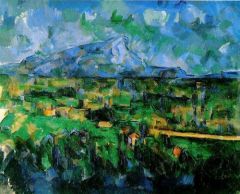
|
Artist: Paul Cezanne Title: Mont Saint-Victoire Date: 1902-06 Period: Post Impressionism Medium: Oil on canvas Here the brush work acts the part of the individual musician in a superbly integrated symphony orchestra. Each stroke exists fully in its own right, but each is nevertheless subordinated to the harmony of the whole. This is both a structured and a lyrical painting, one in which the artist has achieved the integration of structure and color, of nature and painting. |
|
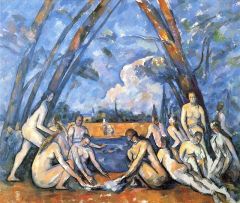
|
Artist: Paul Cezanne Title: The Large Bathers Date: 1906 Period: Post-Impressionism Medium: Oil on canvas Philadelphia Museum of Art In many ways the culmination of 30 years of experiment with the subject of female bathers in an outdoor setting, was painted in the year of Cezanne's death and is unfinished. In it the artist subsumed the fierce emotions expressed in the earlier Battle of Love within the grandeur of his total conception. (Moved away from the somber tonality and sculptural modeling of the 1860s into an approximation of the light blue, green, and white of the Impressionists. Subdues his greens with grays and blacks, and expresses an obsession with the sexual ferocity he is portraying that is notably different from the stately bacchanals of Titian and even more intense than comparable scenes by Rubens. Still exploring the problem of integrating figures or objects and surrounding space.) |
|
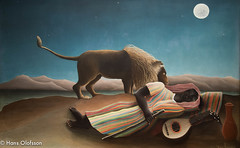
|
Artist: Henri Rousseau Title: The Sleeping Gypsy Date: 1897 Period: Post-Impressionism Medium: Oil on canvas The Museum of Modern Art The Sleeping Gypsy is one of the most entrancing and magical paintings in modern art. By this time he could create mood through a few elements, broadly conceived but meticulously rendered. The composition has a curiously abstract quality, but the tone is overpoweringly strange and eerie a vast and lonely landscape framing a mysterious scene. This painting was lost for years until it was rediscovered in 1923 in a charcoal dealer's shop by the art critic Louis Vauxcelles. During his later years, Rousseau became something of a celebrity for the new generation of artists and critics. |
|
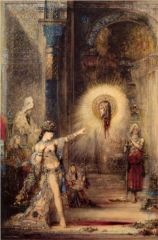
|
Artist: Gustave Moreau Title: The Apparition Date: 1876 Period: Post-Impressionism Medium: Oil on canvas Fogg Art Museum, Harvard University Art Museums He conveys his subject with meticulous draftsmanship and an obsessive profusion of exotic detail combined with jewel-like color and rich paint texture. Moreau's spangled, languidly voluptuous art did much to glamorize decadence in the form of the femme fatale, or "deadly woman." The concept of woman as an erotic and destructive force was fostered by Baudelaire's great series of poems Les Fleurs du Mal ("The Flowers of Evil") (1857) and the mid-century pessimistic philosophy of Arthur Schopenhauer. Among scores of male artists in the last decades of the nineteenth century, Salome frequently served as the archetype of a castrating female who embodied all that is debased, sexually predatory, and perverse. |
|
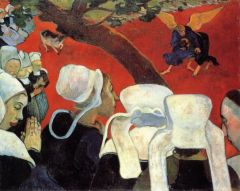
|
Artist: Paul Gauguin Title: Vision after the Sermon Date: 1888 Period: Post-Impressionism Medium: Oil on canvas National Gallery of Scotland, Edinburgh This a startling and pivotal work, a pattern of red, blue, black, and white tied together by curving, sinuous lines and depicting a Breton peasant's biblical vision of Jacob wrestling with the Angel. The innovations used here were destined to affect the ideas of younger groups such as the Nabis and the Fauves. Gauguin has here constricted his space to such an extent that the dominant red of the background visually thrusts itself forward beyond the closely viewed heads of the peasants in the foreground. |
|

|
Artist: Paul Gauguin Title: Where Do We Come From? What Are We? Where Are We Going? Date: 1897-98 Period: Post-Impressionism Medium: Oil on canvas Museum of Fine Arts, Boston Over 12 feet long, this is the most ambitious painting of Gauguin's career. It presents a summation of his Polynesian imagery, filled with Tahitians of all ages situated at ease within a terrestrial paradise devoid of any sign of European civilization. The multiple forms and deep spaces of this complex composition are tied together by its overall tonalities in green and blue. It was this element--color--that the artist called "a mysterious language, a language of the dream." |
|

|
Artist: Vincent Van Gogh Title: The Night Cafe Date: 1888 Period: Post-Impressionism Medium: Oil on canvas Yale University Art Gallery, New Haven The Night Cafe is a nightmare of deep green ceiling, blood red walls, and discordant greens in the furniture. The perspective of the brilliant yellow floor is titled so precipitously that the contents of the room threaten to slide toward the viewer. The result is a terrifying experience of claustrophobic compression that anticipates the Surrealist explorations of fantastic perspective, none of which has ever quite matched it in emotive force. |
|
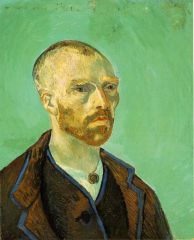
|
Artist: Vincent Van Gogh Title: Self-Portait Date: 1888 Period: Post-Impressionism Medium: Oil on canvas Fogg Art Museum, Harvard University Art Museums Inspired by Japanese printmaking, the construction of his face, placement and shape of his eyes, the beautifully sculpted head |
|

|
Artist: James Whistler Title: Nocturne in Black and Gold Date: 1875 Period: Post-Impressionism Medium: Oil on canvas |
|
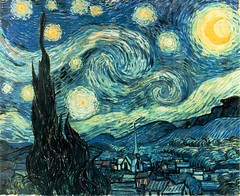
|
Artist: Van Gogh Title: Starry Night Date: 1889 Period: Post-Impressionism Medium: Oil on canvas
|
|
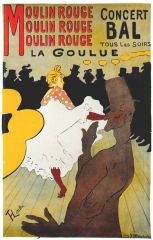
|
Artist: Henri Toulouse-Lautrec Title: Moulin Rouge-La Goulue Date: 1891 Period: Post-Impressionism Medium: lithograph Victoria and Albert Museum, London |

